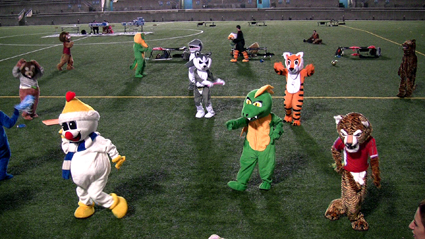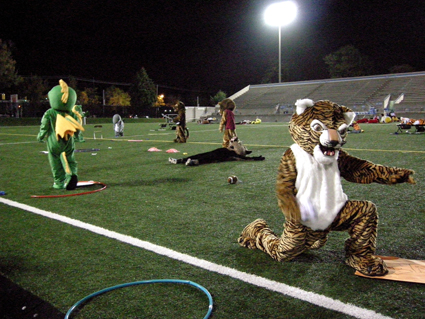live art-activated launceston
keith gallasch: interview, junction arts festival director, natalie de vito

I Promise It Will Always Be This Way, John Sasaki, video still, courtesy the artist
DISTINCTIVE ARTS FESTIVALS ARE SPRINGING UP AROUND REGIONAL AUSTRALIA, BRINGING IN NATIONAL AND INTERNATIONAL ARTISTS, COMMISSIONING AND PRODUCING WORKS BY LOCAL ARTISTS AND ENTICING COMMUNITY MEMBERS TO BECOME ACTIVE COLLABORATORS AND PARTICIPANTS.
Live art’s inherent flexibility and its inclination to interactivity make it ideal for a new generation of community-oriented art-making. Add to that an older tradition of site-specific creativity and you have a potent mix, as demonstrated by the 2012 program of Launceston’s Junction Arts Festival. I spoke with the festival’s director, Natalie de Vito, about several works in the program that exemplify the festival’s goals.
What kind of audience do you envisage for the event?
Our focus is on participatory arts projects and live arts as a means for us to engage with quite a wide range of audiences. That includes the arts community in Launceston, across Tasmania and beyond. We’re slowly building up an international presence, bringing international artists here but trying to develop collaborations too. From a regional perspective, one of the things we’re trying to do is to build practice here through a residency program. One of the things that makes us unique is that we also produce almost all of those works or commission them.
We’re very much involved in the development of the site-specific nature of the works, really trying to activate the city. We bring national and international artists in for several weeks—we have an artist this year who will be in residence for five weeks. I hope for next year’s festival that will be longer.
Duration is really important then?
Absolutely. It’s about the give-and-take between an artist and the community. We hire local artists to work as co-ordinators, to collaborate by directing some of the quite specific components of the performances. They’re very much involved if they’re not already producing a project of their own that we’re helping to create.
Some of the work you’re bringing in is from mainland Australia as well as overseas?
We’ve got En Route by One Step at a Time Like This, who are Melbourne-based. They’re actually in London right now—they’ve recreated the piece they did for the Melbourne Fringe for the Cultural Olympiad. It’s a 90-minute kind of psycho-geographic walking tour of the city as a solo experience. It’s a really beautiful, quite meditative piece that they recreate in every city. It’s been to Brisbane, Edinburgh Fringe, Chicago and they’re on their way to New York.
A guardian guides each participant using headphones, iPod and mobile phone, directing them through a 90-minute theatre of the city. One Step at a Time is a collective of four artists. They came to Launceston on two residencies to develop the piece here. They very much focus on embedding themselves within the city, researching its history and some of its key elements. The amazing thing about it is that everything in the city suddenly becomes a possible part of the piece. You’re in an extremely heightened state such that the person who walks in front of you could be part of the performance.
The everyday becomes unusual.
Most definitely, which is what we’re trying to do in terms of the vision of the festival. We have over 50 events including live performances and music and evening club performances. But the majority of the live arts projects that we helped produce are site-specific so that Launcestonians and visitors can think about this city in a new way. It’s very much focused on using places like alleyways where people might not normally go, or the shop that’s been empty for two years which we’ve taken over as part of a pop up event. So people stop and think for a minute about how we might re-use the city.
What about the Branch Nebula work which presumably makes a different kind of use of the skate park?
In a number of their performances Branch Nebula have brought street culture into a formal theatre space, with skateboarding and BMX bikes and parkour. Now they’ll bring that into the skate park where they’ll collaborate with the local users to devise a piece. They’re coming for a three-week residency. The performance will start in the city in a warehouse space and wind up at the skate park. On the way it will stop at places where the kids maybe go to skate at night time because one of the alleyways is lit really well or a particular set of stairs has got a really great railing. Branch Nebula are really open to collaboration and being guided by their participants. It’ll be like a tour through the city with mini-performances, finishing at the skate park but with the performers and participants blending with the other users of the park.
From a dance and theatre perspective, quite a lot of people will attend to see what Branch Nebula is doing. But this is also a really amazing opportunity for us to access a huge group of young kids and skaters who maybe would never think that they would be interested in contemporary experimental dance and choreography.
What about the John Sasaki project, I Promise It Will Always Be This Way? Who will perform the 26 mascot characters?

I Promise It Will Always Be This Way, John Sasaki, video still
photo Murray Vallis
I Promise It Will Always Be This Way, John Sasaki, video still
They will be locals. This piece was originally created in Toronto at an all-night Nuit Blanche project. It was a 12-hour durational event from dusk till dawn. In bringing it here as a six-hour event we adapted it to make it suitable to the festival and the location and as well translate it from its very specific Canadian/North American identity. One of the things that we have been working on with John is that the first 26 mascots in the original performance were unrelated to any particular brand—there’s a tiger and a lizard and whatever else. One of the things we changed for this performance is that they’re all linked to a particular community organisation or they’re a corporate sport mascot. So we’ve got a Blood Drop (Australian Red Cross Blood Service), Healthy Harold (Life Education Australia) and a range of corporate mascots. John is interested in how this will change the performance. As well, the mascots are going to be linked with local area sports clubs and schools, with each participant having a run-through banner. The project in itself is essentially a massive spectacle about everything around sport and the enthusiasm and excitement of it—but without the sport.
What’s at the core of the work?
It’s a very conceptually driven performance built around failure and the idea that mascots give 110% but for 30 seconds or two minutes at a time. It’s impossible to maintain that intensity of enthusiasm over six hours. So what happens to that generosity of spirit over that time and how does that play out?
It’s quite a spectacular piece. Part of the performance really is about how the performers deal with it. There are sleeping cots on the field if they want to have a nap. There’s a little lunch station. If they need to take their mascot head off, they can. The performance is about the generosity of spirit between the mascots and the relationship between them and the audience. Neither can exist without the other. The show looks at failure but at the same time there’s also something really beautiful about it.
Is there a work by a local artist that engages with the community?
There’s local artist Stuart Muir-Wilson’s Guerilla Gardening. Stuart’s creating vegetable gardens that will pop up around the city. For example, we have one in a car park, and audience members and passers-by will be asked to feed the meter so that the garden doesn’t get a ticket. He’s made the gardens in palettes and we’ve had really tremendous support around the project. Stuart is doing his Masters at the University of Tasmania in the Architecture department focusing on sustainability and environmental science, landscaping and urban design—how we can reconsider disused space, maximising it for community need and good. We’re also looking at how we can take Launceston City Council owned properties or disused business properties to create little moments of utopia but also something that’s quite productive that the general public can come to and use. It’s about places that can be respected, that the general public feels compelled to participate in, to weed and keep safe.
What is your background?
I’m Canadian. I studied art history and I ran a contemporary art gallery in Toronto so my interest in practice came from site-specific installations and performative works in public places as well as live arts and social practice. I was also the artistic producer of the theatre company Mammalian Diving Reflex. So I have a kind of cross between visual arts and theatre. I did quite a bit of theatre production and devising and, within that structure, similar participatory live art style works.
Did you travel with Mammalian Diving Reflex?
Yes, quite extensively. I travelled to Australia most, with the Haircuts by Children show and also the Children’s Choice Awards. I’d been to Launceston a few times doing three other projects with MDR. The first Junction Festival was part of the Regional Arts Conference. Ian Pidd, who’s the Artistic Director of Junction, programmed the festival to coincide with the conference. It was only meant to be a one-off event. Following the festival there was quite a bit of interest from Arts Tasmania and also Launceston City Council about the possibility and need for some kind of event like this that was focused in the north of Tasmania. So, I happened to be in Launceston a few months following and was brought into the conversation about how it could potentially work. I put together the proposal for turning it into an annual festival. That’s how I ended up getting inadvertently pulled in as Festival Director with Ian as Artistic Director. I lead the long-term vision and the direction of the festival and we both co-program the artworks. It’s very collaborative.
I like the sound of Red Brigade vs Blue Brigade—Melbourne’s 10-piece all girl brass band, The Red Brigade, competing with locals in the streets.
There’s a huge number of brass bands in Launceston and we’ve been able to collaborate with them and with local schools and music clubs. That’s another way we’ve been able to try to outreach to the larger community and try to get them involved. I think it’ll knock the people’s socks off!
Junction Arts Festival, Launceston, Tasmania August 22-26; www.junctionartsfestival.com.au
RealTime issue #110 Aug-Sept 2012 pg. 13






